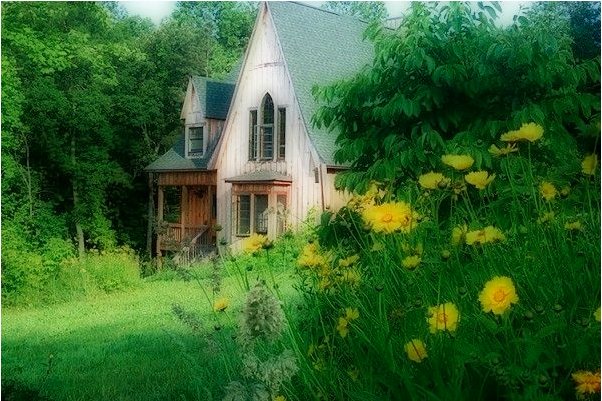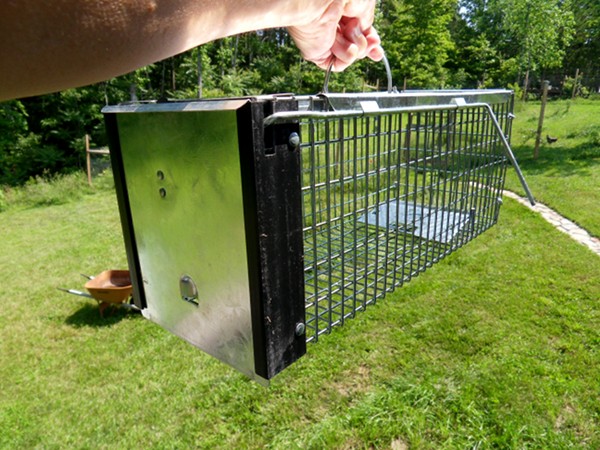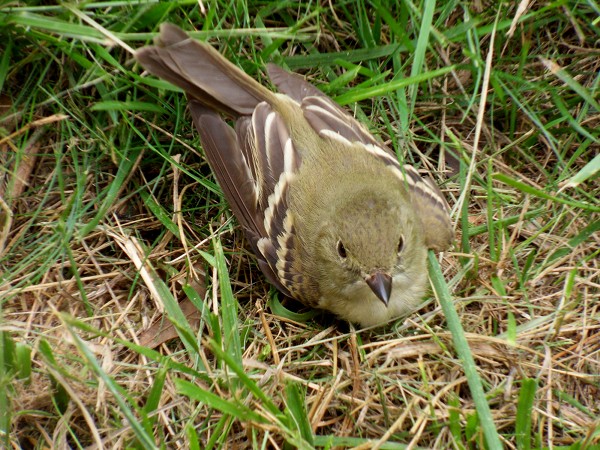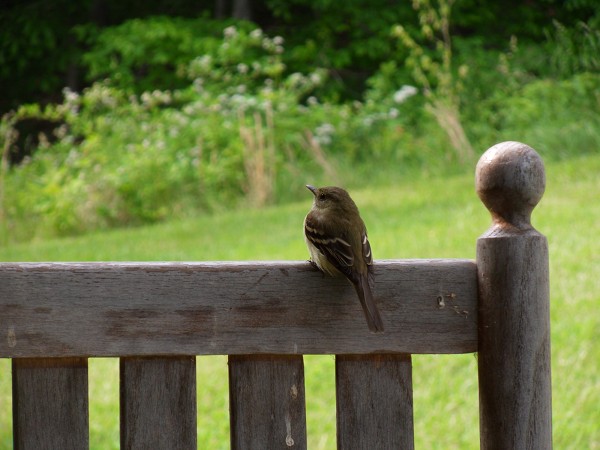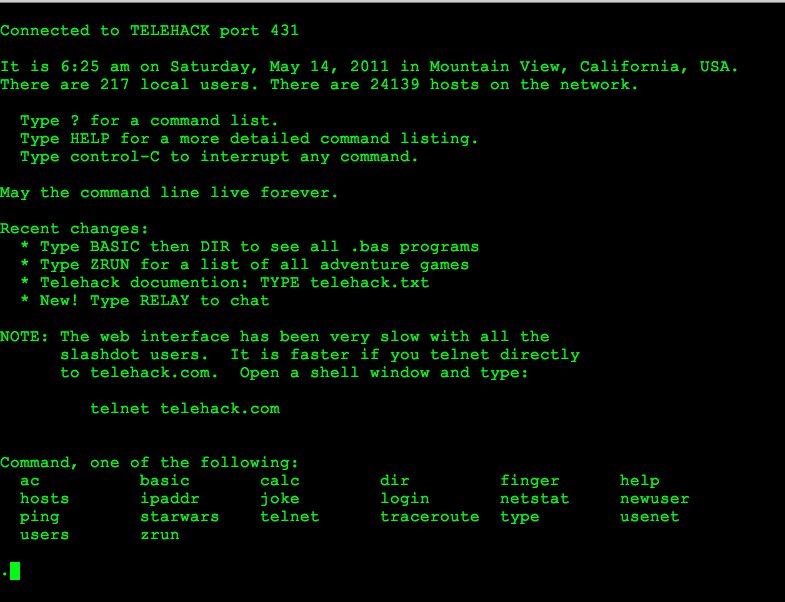The rabbit ran back into the rabbit patch before I could get any closer. It was out for its evening silflay.
Month: May 2011
Digital Kinkade?
A friend sent me this altered photograph today. He took a copy of a photo on this blog, then applied digital effects to the photo using tools at BeFunky.com. I guess I’m getting ever closer to making Acorn Abbey look like a Thomas Kinkade painting, as long as some digital effects are applied.
The wildflower patches and day lilies will be blooming soon. Then I can take photos with much more color.
Yes, I’m aware that sophisticated artsy types look down on Thomas Kinkade. But I’m not ashamed to say that I like his cottage paintings. They evoke a simpler, more innocent, more rural, more self-reliant time. And what could be wrong with that?

A Thomas Kinkade painting
Watership Down
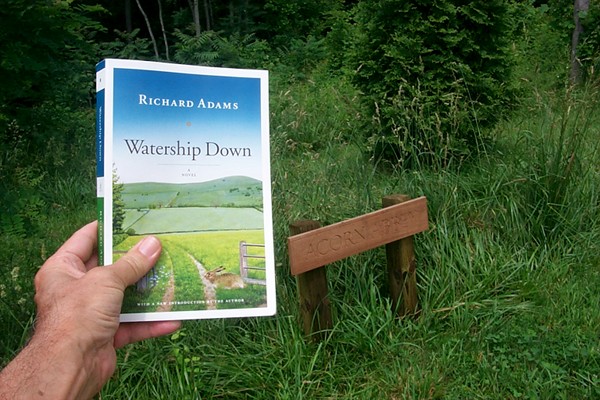
Looking toward the rabbit patch at the abbey
I first read Watership Down back in the 1970s, soon after the book first came out. Wikipedia says the book was turned down by 13 publishers before it was finally accepted by a small publisher. It was an instant classic and has sold more than 30 million copies.
After I saw rabbits kicking up their heels near Acorn Abbey’s rabbit patch this spring, I decided to read the book again. It completely stands the test of time and totally deserves to be a classic. Not only is the story compelling, it’s also a wonderful nature book, with descriptions of terrain and habitat that sometimes remind one of Tolkien. The story is about some rabbits who think outside the box and make a new home after Fiver, a rabbit who has visions, foresees that their warren will soon be destroyed by a bulldozer.
I suspect that reading Watership Down back in the ’70s made me much more sensitive to wild animals’ need for habitat and the destruction of that habitat by carelessness and suburbanization. One of the things I’ve tried to do at Acorn Abbey is create as much animal habitat as possible on my little five acres, even though I’ve learned that if the gentle little vegetarian animals move in, the predators will come too.
Watership Down can be ordered from Amazon.

Rabbit on the doorstep at Acorn Abbey, summer 2010. Photo by Ken Ilgunas.
Got a revolution?
Jefferson Airplane, Woodstock 1969: Got to Revolution
I am dumbfounded at the passivity of today’s young people, particularly recent college graduates. If they got any education at all for the money they spent on a college education, then they ought to be able to see that they are among the designated losers in an already almost-lost class war being waged by the corporate and political elite against the people of America.
My generation would never have put up with it. Even if we lost the struggle, we’d be in the streets raising raising hell and having a good time at it. To quote Jefferson Airplane from the song they sang at Woodstock in 1969:
Look what’s happening out in the streets
Got a revolution got to revolution
Hey I’m dancing down the streets
Got a revolution got to revolution
Ain’t it amazing all the people I meet
Got a revolution got to revolution
One generation got old
One generation got soul
This generation got no destination to hold
Pick up the cry
Hey now it’s time for you and me
Got a revolution got to revolution
Come on now we’re marching to the sea
got a revolution got to revolution
Who will take it from you
We will and who are we
We are volunteers of america
The statistics are appalling. Surveys show that 85 percent of this year’s college graduates will be forced to move back home with their parents. Their average student debt is $27,200. Data from the U.S. Bureau of Labor Statistics shows that at least half of college-educated people under age 25 are unemployed or working for low wages in dead-end jobs such as bartending. A survey showed that 71 percent of recent college graduates wish they’d done something differently while they were in school to better prepare for the job market. In other words, they’re blaming themselves.
I already detect that some young readers are about to click the comment button and say that this is a generational problem: That my generation, which grew up in the ’60s and ’70s, got all selfish and self-indulgent as we aged, in spite of our youthful idealism, and that we screwed up the world. Don’t bother, because that’s just right-wing propaganda. The vast majority of we Boomers who grew up in the ’60s and ’70s worked our butts off all our lives to raise the generation that’s now moving back home. The tax money we Boomers paid out was the greatest source of revenue this country ever had. This was not a generational failure, this was a right-wing project: To capture the government and regulatory agencies to serve corporate interests, to shift the tax burden down, to redistribute income up, to starve the schools and the social safety net, to shift government expenditures toward profitable business projects such as war, to privatize profits and socialize costs, and to saturate Americans with propaganda so that we blame the poor, the hard-working, and the weak for the country’s problems while building right-wing hero myths around weak-minded, sociopathic pipsqueaks like Ronald Reagan and George Bush.
Right-wingers say that the country is broke. Ha! The United States is richer than ever, so awash in cash that new speculative bubbles may again be forming. Corporate profits are at record highs. The rich are richer than ever, and paying far less in taxes than they used to. There is plenty of money, but all the gains are going to the top. In Reaganomics, you’ll remember, that was the excuse for reducing taxes on the rich and ending regulations on corporations and Wall Street — it would create jobs. How’s that working out for you, recent college graduates? And how do you like the new line that’s coming out of the corporate propaganda machine, that college degrees are a hoax? That’s the new propaganda line: It’s not that economic elites are capturing all the new wealth and productivity gains, it’s that college degrees are a hoax.
Each year, about 3.2 million young people graduate from American colleges and universities. There must now be millions of college-educated young people unemployed and/or living at home. What the devil are they doing with all that free time? If they organized themselves and took to the streets, they all by themselves would have the power to take back the American democracy from corporate control and to get this country’s wealth back into the hands of the people who produce it rather than the greedy, unproductive hands of those who skim, scam, exploit, and tax-avoid their way to the top.
How I wish that today’s young people would start raising a little hell and pushing back against the elites who’ve eaten their lunch and offshored their future. Taking to the streets and civil disobedience are very effective strategies. Right-wingers know this. That’s why rich oilmen like Charles and David Koch pay good money to organize those fake little made-for-TV Tea Party rallies.
If you’re looking for an organization to get started with, consider U.S. Uncut. They’re a sassy new disobedient but non-violent organization going after greedy corporations and the corporate capture of government. They need help starting local chapters.
You don’t even have to have a revolution. You only need to claw back the American democracy from the corporate forces that have bought it with their obscene profits, and shout down the lies of the right-wing propaganda machine.
Right-wing propaganda update: This is from a transcript of Rush Limbaugh’s radio show yesterday:
LIMBAUGH: Young people are moving back in with them. Their moms and dads! And some of these people moving back in are 35 and 40. How old are their moms and dads? 60 and 70, try. But they’re 60 and 70 and if they can afford their worthless offspring moving back in with them, just how poverty-stricken are they?
Another update: Ken Ilgunas has written a response to this post on his blog, “Why aren’t we revolutionaries?”
Prime suspect: weasel
After some Googling and discussion with old hands at keeping chickens, Ken and I are of the opinion that the most likely suspect in the killing of our two young chickens last week is a weasel.
Googled sources say that there are indeed weasels in North Carolina. Several sources say that weasels, pound for pound, are the most vicious predators of all. They can get through amazingly small openings.
We’re going to attempt to trap the weasel. I bought a trap. It’s a live trap, a Havahart model 0745. The trap arrived today. We’ll set it for the first time tonight and see what happens. I plan to use an egg as bait.
Two nights ago, there were blood-curdling animal screams in the woods below the house. Lily ran and hid inside her hiding chair. I’m pretty sure it was not a bird. It was so loud that it couldn’t have been too small an animal. The sound was too shrill and cat-like, I think, to have been a fox. I’m wondering if there’s a new predator in the neighborhood that is tangling with more animals — possibly competing predators — than just the chickens.
Let’s hope the trap works.
There's always wildlife drama
There is such a variety and abundance of wildlife around the abbey that there’s always some kind of wildlife drama going on. Recently Ken was sitting in the rocking chair on the side porch. A bird flew right past him, hit the window, and fluttered into the yard. It was alert, but stunned. We left it alone until it came to its senses. Eventually it flew to the rocking chair, perched a few minutes collecting its wits, and flew off.
Can anyone identify this bird?
First cabbage
It wasn’t all that long ago that the cabbage plants were seedlings under the grow light, less than an inch high. Today we harvested the first cabbage. It’ll be served tonight at supper, when we’ll be joined by one of Ken’s former professors who is coming over from Durham.
On Monday we froze four gallons of strawberries, fresh-picked (though we didn’t pick them this time) at Mabe’s Berry Farm near Walnut Cove.
Ken with his favorite chicken, Patience.
Wildflowers in the landscape
When you’re starting a new landscape, and when you’ve got lots of area to fill, it makes sense to have some wildflower patches. Last year I flung a bunch of coreopsis seed in some rough areas where I was not mowing. The coreopsis didn’t bloom in its first year, but this year it’s making a good show.
I had three rough areas, two of them fairly large, where the soil was poor and the ground had never been leveled enough to start grass. Early this spring, with Ken’s help, we tilled those areas, threw on organic fertilizer and compost, and planted wildflower seeds — very densely. Those areas now have lush stands of wildflowers more than a foot tall, but they’re not yet blooming. They’re going to make dramatic stands of wildflowers. I’ll have photos of that later in the summer when the blooming is going strong.
Wildflower seeds can be in bulk, but the pound, from places like OutsidePride.com. I’ve found their seeds to be of very good quality.
We’ve been eating broccoli from the garden for days now. This cabbage will soon be ready to go to the kitchen.
Life goes on…
The chickens — Patience, Chastity and Ruth — seem to have developed a new behavior. This morning the three of them gathered along the fence at the bottom of the garden, at the point nearest the house, and sang. They were looking toward the house while they sang, and it went on for quite some time. I feel sure it was a form of communication, aimed at Ken and me, and I think it meant, “Please brings us some mash and some treats, right now.”
If one hen sings alone, my first assumption would be that she just laid an egg. If two hens sing together, I’d assume they’re having a conversation. If three hens sing together, it is amazingly operatic, and quite beautiful, actually. Listening to their aria this morning I was very aware that the hens have long been part of the family.
Which brings me to something I’ve been procrastinating on writing about, because I don’t enjoy telling sad stories. The two baby chickens are gone, taken by predators a week ago. They had been living downstairs in the henhouse, with the big chickens upstairs. A predator worried its way through the joint in the wire where the upper wire fabric connects with the wire fencing underneath the chickenhouse. The amount of strength and dexterity required to have gotten through the wire was impressive, though the hole was not large. But somehow something fairly small, and very strong, got in. I suppose it could have been a raccoon, though some have asked whether there might be weasels in the area. I don’t know.
It’s small comfort to try to be philosophical and just say that that’s the way of nature, that everybody wants a chicken dinner. I feel a certain amount of shame, because I was responsible for protecting those chickens. I’m also daunted by the difficulty of upgrading the defenses and trying again with more baby chickens. But it must be done. The three hens are so productive, and so sweet to have around, that I can’t imagine not having chickens. I wish that all farm animals could be as content and as well cared for as Patience, Chastity and Ruth.
Meanwhile, now that spring is busting out all over — especially with the excellent rains and good growing weather we’ve had this month — I am stunned at the explosion of life around the abbey. Everything is lush and green. The roses, the honeysuckle, and some of the wildflowers are blooming. I believe there are five times more birds this year than there were last year. They’re attracted by the ever denser, natural-looking habitat. I’ve seen baby rabbits, baby groundhogs, baby squirrels, and baby voles. There are birds’ nests all over the place. Yesterday Ken and I saw young bluebirds practicing their flying, being watched over by their parents. A mocking bird’s nest in one of the arbor vitae trees contains three eggs. Three times we’ve seen the terrapin that lives in the rabbit patch and have had to carry it out of the yard. I’ve seen skinks fornicating, and several times Lily has caught skinks in the house. She never hurts the skinks, even when she carries them in her mouth. She only wants to use them as toys. When we take the skinks outside, we’ve started carrying them some distance from the house, hoping to reduce the population of “porch lizards,” which has gotten a bit out of hand. The voles also are out of hand (and out of the day lily patch and into the garden) and have been clambering up the pea vines and eating peas. I’ve ordered vole traps (live traps). I’ll probably have to take the captured voles at least a couple of miles away to keep them from coming back. A mocking bird has been stealing strawberries. The doves flock to the chickens’ feeder. The bird bath is increasingly popular. Ken and I may be monks, but the critters around here are not. They are incredibly fecund, gregarious, and happy. During May this place is like a Myrtle Beach for wild animals.
But some animals do eat other animals. I don’t think I’ll ever get used to that. Or, as Edna St. Millay said, talking about death, “I know. But I do not approve.”
The Internet as it used to be
Warning: This is a nerd post!
People sometimes ask me how long I’ve been on the Internet. I’ve been on the Internet since the mid-1980s. Then when people ask me what the Internet was like back then, I find the question almost impossible to answer. It’s simply too geeky for most people to want to bother to understand. Telehack.com has reconstructed the Internet (using large archives of text files) as it appeared around 1991. In a second I’ll explain how you can try out the early Internet on Telehack.com’s simulation.
First of all, the early Internet (or Arpanet, as it was called in the 1980s) was text-based. Everything happened on a command line. Also, you had to thoroughly know Unix and have access to a Unix system that was connected to the Internet. It really helped if you were an engineer. If you weren’t an engineer, you sure as heck needed to know some engineers (luckily, I did).
At the campuses and big research labs, there were early forms of local-area networks. Most long-distance traffic, though, was carried over the long-distance telephone network. Unix computers knew how to call, and connect to, other Unix computers as needed. Long distance costs were very expensive then. Luckily, my computer never had to make those long-distance calls. The phone companies operated Internet computers, and if you asked nicely and knew the right people, the system administrators of those big phone company computers would call you so that you didn’t have to call them. My computer, which was named gladys, had close connections to a computer named pacbell (run by Pacific Bell in California), and ihnp4, run by AT&T/Bell Labs in Indian Hill, Illinois, near Chicago.
My first email address was “ihnp4!gladys!dalton.” As new standards for addressing were developed, this could later be shortened to “dalton@gladys.” The standard that brought the .com, .org, .edu, etc., extensions had not yet been developed.
Anyway, if you go to Telehack.com, you can try out some of the early Internet commands. Type your command at the blinking cursor. If you type the command “hosts”, you’ll get a scrolling list of the major computers on the Internet, in alphabetical order. You’ll see my computer, gladys, in the list, and yep, gladys passed muster as a major computer (she was an AT&T 3B2 running System 5 Unix). Try the command “finger dalton@gladys”. You can also try the command “ping gladys”.
If you type the command “traceroute gladys”, you’ll get some idea of how data was passed from computer to computer on the early Internet until it reached its destination. The route from telehack to gladys could be expressed as “telehack!mimsy!ames!pacbell!gladys”. This means that telehack and gladys did not talk to each other directly. Rather, telehack knows mimsy, and mimsy knows ames, ames knows pacbell, and pacbell knows gladys. “Ames” is Ames Laboratory.
You’re probably wondering what “ihnp4!gladys!dalton” means. Bell Labs’ computer ihnp4 was probably the No. 1 best-known, best-connected computer on the civilian Internet. Everybody knew who ihnp4 was. So what that old email address means is, if you want to send something to dalton, send it first to ihnp4. Then ihnp4 knows how to communicate with gladys, and dalton is a user on gladys. Early email addresses could get quite long with lots of “!” separators if you were way out on the fringes of the Internet. Gladys was a lucky computer. She spoke directly with the big guys, and so my one-hop (ihnp4!gladys) email address was a very high-status email address in those days.


